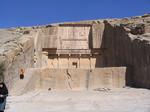|
Artaxerxes IV (old-Persian Artakhšaça): name of a
Achaemenid king of the Persian empire, ruled
338-336. His real name was Arses.
Arses was a son of the Persian king Artaxerxes
III Ochus (358-338), and succeeded his father.
According to a Greek source, Diodorus of Sicily, the
powerful eunuch Bagoas poisoned many members of the
royal family, but a cuneiform tablet in the British
Museum (BM 71537) suggests that the king died from
natural causes. However this may be, it happened in
September 338, and it is probable that Bagoas killed
everyone to make sure that Arses, who is presented
by Diodorus as some sort of a puppet king, became
the new ruler of the Achaemenid empire.
Alternatively, Arses ordered the executions himself.
This is not uncommon.
From an inscription from Xanthus, we know that
Arses accepted the same throne name as his father
and grandfather, Artaxerxes.

The Tomb of
Artaxerxes III.
Arses' final
resting place?
The death of Artaxerxes III caused great
upheavals in the Achaemenid empire and it is certain
that Bagoas and Artaxerxes IV were unable to get a
firm grasp on the situation. At least two satrapies
revolted: Egypt, which had recently been conquered
by Artaxerxes III, and Babylonia (although the
evidence for the insurrection of Nidin-Bêl is
meager). To add to these troubles, the king of
Macedonia, Philip II, prepared an attack on Persia's
possessions in what is now Turkey. His trusted
general Parmenion crossed the Hellespont in the
spring of 336, and several Greek cities sided with
the invader.
Under these circumstances, it comes as no
surprise that the Persian nobility was divided.
Prince Artašata, a distant relative of Artaxerxes
and satrap of Armenia, seems to exercised pressure.
He was a powerful man and a formidable warrior, and
he received support from several noblemen (e.g.,
Pharnabazus). Diodorus says that Artaxerxes wanted
to remove Bagoas (text) and that this forced Bagoas
to kill this king as well (summer of 336). The
cuneiform text know as the Dynastic prophecy
suggests that Artašata marched on Persepolis and
seized the throne. Whatever may have happened,
Artašata now became king under the name of Darius
III Codomannus.
One of his first acts was the execution of
Bagoas. For a few months there was a respite: there
was a strong king who was able to reunite the
kingdom, and Philip was murdered (October 336).
Moreover, a Greek mercenary general in Persian
service, Memnon of Rhodes, was able to push back
Parmenion. However, Philip was succeeded by his
young son Alexander the Great, who joined Parmenion
(May 334), and launched the campaign that ended with
the fall of the Achaemenid empire and the death of
Darius III (330).
There is one badly damaged source, quoted here, that
suggests that Artaxerxes decided to restore the
Babylonian temples Esagila and Etemenanki. The
project was executed by Alexander.
The reign of Artaxerxes IV Arses was short but
important, because the seeds were sown for the
ultimate downfall of Persia. |